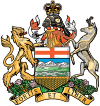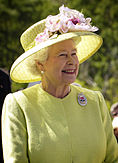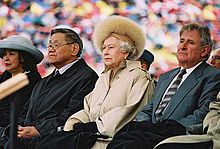- Monarchy in Alberta
-
Queen in Right of Alberta Monarchy Provincial/State 
Coat of arms of Alberta
Incumbent:
Elizabeth II
Queen of Canada
since 6 February 1952Style: Her Majesty First monarch: Edward VII Formation: 1 September 1905 By the arrangements of the Canadian federation, Canada's monarchy operates in Alberta as the core of the province's Westminster-style parliamentary democracy.[1] As such, the Crown within Alberta's jurisdiction is referred to as the Crown in Right of Alberta,[2] Her Majesty in Right of Alberta,[3] or The Queen in Right of Alberta.[4] The Constitution Act, 1867, however, leaves many royal duties in Alberta specifically assigned to the sovereign's viceroy, the Lieutenant Governor of Alberta,[1] whose direct participation in governance is limited by the conventional stipulations of constitutional monarchy.[5]
Contents
Constitutional monarchy in Alberta
The role of the Crown is both legal and practical; it functions in Alberta in the same way it does in all of Canada's other provinces, being the centre of a constitutional construct in which the institutions of government acting under the sovereign's authority share the power of the whole.[6] It is thus the foundation of the executive, legislative, and judicial branches of the province's government.[7] The Canadian monarch — since 6 February 1952, Queen Elizabeth II — is represented and her duties carried out by the Lieutenant Governor of Alberta, who's direct participation in governance is limited by the conventional stipulations of constitutional monarchy, with most related powers entrusted for exercise by the elected parliamentarians, the ministers of the Crown generally drawn from amongst them, and the judges and justices of the peace.[5] The Crown today primarily functions as a guarantor of continuous and stable governance and a nonpartisan safeguard against the abuse of power.[5][8][9] This arrangement began with the granting of Royal Assent to the 1905 Alberta Act and continued an unbroken line of monarchical government extending back to the late 18th century.[10] However, though Alberta has a separate government headed by the Queen, as a province, Alberta is not itself a kingdom.[11]
 The Queen of Canada (centre) with her vice-regal representative, the Lieutenant Governor of Alberta, Norman Kwong (left), and her Alberta premier, Ralph Klein (right), at the official celebrations of Alberta's centenary, May 23, 2005
The Queen of Canada (centre) with her vice-regal representative, the Lieutenant Governor of Alberta, Norman Kwong (left), and her Alberta premier, Ralph Klein (right), at the official celebrations of Alberta's centenary, May 23, 2005
Government House in Edmonton is owned by the sovereign only in her capacity as Queen in Right of Alberta and is used both as an office and official event location by the lieutenant governor, the sovereign, and other members of the Canadian Royal Family. The viceroy resides in a separate home provided by the provincial Crown and the Queen and her relations reside at a hotel when in Alberta. Members of the Royal Family have owned property in a private capacity: for a number of decades, King Edward VIII (later the Duke of Windsor) owned Bedingfield Ranch, near Pekisko, High River.
Royal associations
Those in the Royal Family perform ceremonial duties when on a tour of the province; the royal persons do not receive any personal income for their service, only the costs associated with the exercise of these obligations are funded by both the Canadian and Alberta Crowns in their respective councils.[12] Monuments around Alberta mark some of those visits, while others honour a royal personage or event. Further, Alberta's monarchical status is illustrated by royal names applied regions, communities, schools, and buildings, many of which may also have a specific history with a member or members of the Royal Family. Associations also exist between the Crown and many private organizations within the province; these may have been founded by a Royal Charter, received a royal prefix, and/or been honoured with the patronage of a member of the Royal Family. Examples include the Royal United Services Institute of Alberta, which is under the patronage of Prince Andrew, Duke of York, and the Royal Tyrrell Museum of Palaeontology, which received its royal prefix from Queen Elizabeth II in 1990.[13] At the various levels of education within Alberta there also exist a number of scholarships and academic awards either established by or named for members of the Royal Family.[14]
The main symbol of the monarchy is the sovereign herself, her image (in portrait or effigy) thus being used to signify government authority.[15] A royal cypher or crown may also illustrate the monarchy as the locus of authority, without referring to any specific monarch. Additionally, though the monarch does not form a part of the constitutions of Alberta's honours, they do stem from the Crown as the fount of honour, and so bear on the insignia symbols of the sovereign. The Queen or others in her family may bestow these honours in person: the Queen, when in the province in 2002, appointed Alberta citizens to the Royal Victorian Order and presented in Alberta, on her official Canadian birthday in 2005, the insignia of the Venerable Order of Saint John to new inductees.[16]
-
Effigy of Queen Victoria on the Second Boer War monument in Victoria Park, Calgary
-
Lake Louise, named for Princess Louise, and the glacier named for her mother, Queen Victoria
-
The Queen Alexandra School in Queen Alexandra, Edmonton, named for Queen Alexandra
-
The neighbourhood of Prince Charles in Edmonton, named for Prince Charles, Prince of Wales
History
Though Queen Elizabeth II did not tour any part of the province during her Golden Jubilee royal tour in 2002, the legislative assembly and government introduced a number of events and initiatives to mark the anniversary.[17] More than 4,000 Albertans attended the Lieutenant Governor's Jubilee Levée on 23 June, where Lois Hole stated: "what we want to realize is how important the monarchy is to Canada and certainly to Alberta."[14] Three years later, the Queen was in Alberta to mark the province's 100th anniversary of entry into Confederation, where she attended, along with an audience of 25,000, a kick-off concert at Commonwealth Stadium and addressed the legislative assembly, becoming the first reigning monarch to do so.[18] At the same time, the Ministry of Learning encouraged teachers to focus education on the monarchy and to organize field trips for their students to see the Queen and her consort, or to watch the events on television.[19]
See also
References
- ^ a b Edward VII (20 July 1905). Alberta Act. 10. Westminster: King's Printer. http://www.solon.org/Constitutions/Canada/English/aa_1905.html. Retrieved 16 June 2009.
- ^ Crown in right of Alberta v. LRB and Municipal, [1998 Alta. L.R.B.R. 332] (Court of Queen's Bench of Alberta 14 August 1998).
- ^ Elizabeth II (1 January 2002). Canadian Airlines Corporation Act. 1.a. Calgary: Alberta Queen's Printer. http://www.canlii.org/en/ab/laws/stat/rsa-2000-c-c-1/latest/rsa-2000-c-c-1.html. Retrieved 27 June 2009.
- ^ Her Majesty the Queen In Right of Alberta v. Rhonda Fjeld, 0503 02287, 2008 ABQB 558 (Court of Queen's Bench of Alberta 15 April 2008).
- ^ a b c MacLeod, Kevin S. (2008). A Crown of Maples (1 ed.). Ottawa: Queen's Printer for Canada. p. 16. ISBN 978-0-662-46012-1. http://www.pch.gc.ca/pgm/ceem-cced/fr-rf/crnCdn/crn_mpls-eng.pdf.
- ^ Cox, Noel (September 2002). "Black v Chrétien: Suing a Minister of the Crown for Abuse of Power, Misfeasance in Public Office and Negligence". Murdoch University Electronic Journal of Law (Perth: Murdoch University) 9 (3): 12. http://www.murdoch.edu.au/elaw/issues/v9n3/cox93.html. Retrieved 17 May 2009.
- ^ Privy Council Office (2008). Accountable Government: A Guide for Ministers and Ministers of State – 2008. Ottawa: Queen's Printer for Canada. p. 49. ISBN 978-1-100-11096-7. http://www.pco-bcp.gc.ca/index.asp?lang=eng&page=information&sub=publications&doc=ag-gr/2008/ag-gr-eng.htm. Retrieved 17 May 2009.
- ^ Roberts, Edward (2009). "Ensuring Constitutional Wisdom During Unconventional Times". Canadian Parliamentary Review (Ottawa: Commonwealth Parliamentary Association) 23 (1): 15. http://www2.parl.gc.ca/Sites/LOP/Infoparl/32/1/32n1_09e_Roberts.pdf. Retrieved 21 May 2009.
- ^ MacLeod 2008, p. 20
- ^ Edward VII (20 July 1905), Alberta Act, Ottawa: King's Printer for Canada, http://www.solon.org/Constitutions/Canada/English/aa_1905.html, retrieved 13 February 2011
- ^ Forsey, Eugene (31 December 1974). "Crown and Cabinet". In Forsey, Eugene. Freedom and Order: Collected Essays. Toronto: McClelland & Stewart Ltd.. ISBN 978-0771097737.
- ^ Palmer, Sean; Aimers, John (2002), The Cost of Canada's Constitutional Monarchy: $1.10 per Canadian (2 ed.), Toronto: Monarchist League of Canada, archived from the original on 19 June 2008, http://web.archive.org/web/20080619203100/http://www.monarchist.ca/new/docs/costofcrown.html, retrieved 15 May 2009
- ^ "Frequently Asked Questions". Royal Tyrrell Museum Cooperating Society. Archived from the original on 16 May 2008. http://web.archive.org/web/20080516141207/http://www.tyrrellmuseum.com/info/index2.php?strSection=9. Retrieved 18 July 2008.
- ^ a b Hoople, Chelsea (2002). "Alberta honours its citizens in the name of the Queen". Canadian Monarchist News (Toronto: Monarchist League of Canada) Autumn 2002. http://www.monarchist.ca/cmn/2002/03spring005.html. Retrieved 27 June 2009.[dead link]
- ^ MacKinnon, Frank (1976), The Crown in Canada, Calgary: Glenbow-Alberta Institute, p. 69, ISBN 978-0-7712-1016-7
- ^ "Her Majesty Queen Elizabeth II, presents the Order of Saint John Insignia" (Press release). Saint John Ambulance. 24 May 2005. http://premier.alberta.ca/royalvisit/st_john_news_release.pdf. Retrieved 27 June 2009.
- ^ Elizabeth II (20 March 2002), Queen Elizabeth II Golden Jubilee Recognition Act, 2, Edmonton: Queen's Printer for Alberta, http://www.canlii.org/en/ab/laws/stat/sa-2002-c-q-0.5/latest/sa-2002-c-q-0.5.html, retrieved 8 August 2010
- ^ Government of Alberta. "Alberta Centennial Home > Official Events > Celebrate Alberta Kick-Off Party". Alberta Queen's Printer. http://www.albertacentennial.ca/events/kickoff.html. Retrieved 28 June 2009.
- ^ Government of Alberta. "Education Home > Centennial Projects > Alberta students encouraged to join the festivities the Royal Visit 2005". Alberta Queen's Printer. http://www.education.gov.ab.ca/centennial/RoyalVisit/bulletin.asp. Retrieved 28 June 2009.
External links
- Ministry of Education (2005). "The Monarchy in Alberta: Teacher and Student Resource". Queen's Printer for Alberta. http://www.education.gov.ab.ca/centennial/RoyalVisit/brochure.pdf.
- Office of the Premier. "Premier > Royal Visit". Queen's Printer for Alberta. http://premier.alberta.ca/royalvisit/.
- Provincial Archives of Alberta. "Culture and Community Spirit > Heritage and Museums > Provincial Archives of Alberta > Reference Services > Royal Visits - Textual Records". Queen's Printer for Alberta. http://www.culture.alberta.ca/archives/referenceservices/royalvisits/textualrecords.aspx.
- Provincial Archives of Alberta. "Culture and Community Spirit > Heritage and Museums > Provincial Archives of Alberta > Reference Services > Royal Visits photos". Queen's Printer for Alberta. http://www.culture.alberta.ca/archives/referenceservices/royalvisits/photographs.aspx.
- Provincial Archives of Alberta. "Culture and Community Spirit > Heritage and Museums > Provincial Archives of Alberta > Reference Services > Royal Visits - Film and Video Sources". Queen's Printer for Alberta. http://www.culture.alberta.ca/archives/referenceservices/royalvisits/film.aspx.
 Canadian monarchy
Canadian monarchyThe Crown Viceroys Constitutional Queen-in-Council · Queen-in-Parliament · Queen-on-the-Bench · Queen's peace · The Canadian Crown and the Canadian Forces · The Canadian Crown and Aboriginal peoplesLegal Ceremonial and symbolic Related Politics of the provinces and territories of Canada Sovereign in the provinces Lieutenant Governors Commissioners Premiers Legislatures Elections OtherCategories:- Monarchy in Canada
- Government of Alberta
-
Wikimedia Foundation. 2010.




